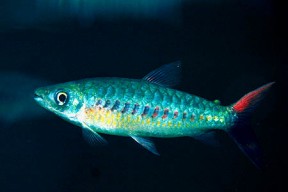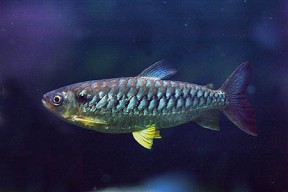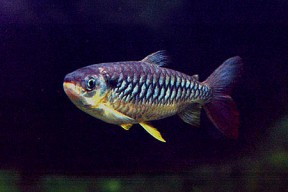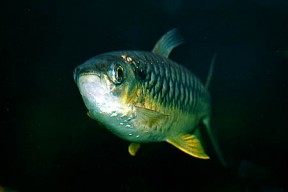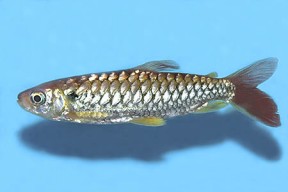Chalceus erythrurus
Tucanfish
Classification
Characidae
Distribution
Parts of the Amazon basin in Peru and Brazil.
Habitat
Inhabits surface waters of floodplain rivers and lakes.
Maximum Standard Length
8″ (20cm).
Aquarium SizeTop ↑
48″ x 18″ x 18″ (120cm x 45cm x 45cm) – 240 litres should be the smallest tank considered. It’s capable of a real turn of speed and can injure itself quite easily in small tanks.
Maintenance
It requires a lot of swimming space, so decor is not really critical, although a sandy substrate with some beech branches and floating plants looks very effective, and mimics many of its natural biotopes. Make sure the tank cover is very well-fitting, as it is a renowned jumper.
Water Conditions
Temperature: 72-78°F (22-26°C)
pH: 6.0-7.0
Hardness: 5-15°H
Diet
Feeds primarily on insects and aquatic crustaceans in nature. While dried foods are usually accepted, a good proportion of the diet should contain meaty foods such as prawns, mussel, bloodworm, chopped earthworms etc.
Behaviour and CompatibilityTop ↑
It does best when kept either as a single specimen, or in a group with more than 6 fish. In smaller groups, the fish tend to scrap with one another. Other than this, it is a good addition to many larger communities. Tankmates can include similarly-sized characins such as Leporinus, Metynnis, Mylossoma and Brycon sp., large Loricariids, Pimelodiids, and cichlids such as Geophagus or Satanoperca sp. Try to avoid other surface-dwelling species unless the tank is huge.
Sexual Dimorphism
Unknown.
Reproduction
Not achieved in the hobby to date. In all likelihood it spawns in a similar fashion to C. macrolepidotus
NotesTop ↑
This species can be distinguished from its congener C. macrolepidotus mainly by the red or yellow (as opposed to pink) caudal fin. In addition, it has yellow pectoral and pelvic fins and may also have some yellow colouration on the body. It is seen for sale as often as its relative, although it’s quite abundant in nature.
